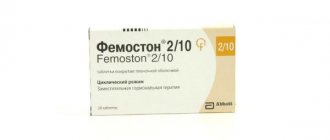What is Duphaston?
Dydrogesterone, the main active ingredient of the drug, which has the trade name Duphaston, is a derivative of the hormone progesterone. It has a selective effect on the mucous lining of the uterus (endometrium). Stops its pathological growth (hypertrophy).
Progesterone is a steroid hormone present in the body of both sexes. In men it is contained in small quantities and in constant concentration, and in women it varies depending on the phase of the menstrual cycle and the period of life. Since dydrogesterone is obtained by artificial synthesis, and human progesterone is not used, this reduces the effect of virilism (that is, the occurrence of secondary male sexual characteristics). For example, extensive hair growth, deepening of the voice, decreased ability to conceive a child, etc.
Taken orally (inside). The active substances, absorbed into the blood and evenly penetrating into the woman’s body, are concentrated in the areas of her genitourinary system. The breakdown products, during the metabolism of dydrogesterone in the liver, are excreted from the body during urination. The half-life of the substance is eighteen hours.
A few words about pathology
The exact causes of the development of both fibroids and endometriosis are not fully known. The role of relative hyperestrogenism is assumed: the amount of the hormone is within the age norm, but in relation to progesterone there is a preponderance towards estrogens. It is believed that the role of progesterone is to inhibit excess tissue growth - proliferation.
On a note
In recent years, this theory has been questioned. There is an opinion that progesterone also stimulates hyperplastic processes in the uterus, and the influence of both female hormones is considered in combination.
Uterine fibroids are a pathological growth of muscle and fibrous tissue that form nodes. Initially, they are subject to external hormonal influence and respond to fluctuations in the concentration of certain active substances in the blood. As the node enlarges, cells appear in it that rearrange their metabolism to autoregulation - the tumor itself releases substances that stimulate its growth. In this situation, the use of hormonal drugs makes no sense.
Endometriosis is a pathological process in which cells of the inner layer of the uterus (endometrium) are found in unusual places:
- Surface of the ovary;
- The fallopian tubes;
- Vagina;
- Deep layers of the uterine wall;
- Peritoneum;
- Intestines.
Rarely, endometriosis of the eyes, lungs and even the navel occurs.
These tissues are subject to hormonal influence from the body and at the same time themselves have such activity. Foci of endometriosis secrete large amounts of estrogen, which leads to hormonal imbalance. This explains the infertility that often accompanies this pathology.
The occurrence of uterine fibroids and endometriosis often has one cause - hormonal imbalance.
Indications for use
Gynecologists and endocrinologists prescribe treatment with the drug for pathologies such as menstrual irregularities:
- Dysmenorrhea (irregular periods) and amenorrhea (cessation of menstruation during childbearing age).
- Endometriosis (growth of endometrial tissue outside the uterus).
- For infertility caused by luteal insufficiency.
- Threat of spontaneous abortion associated with low levels of endogenous progesterone.
- In case of uterine bleeding caused by physiological and mechanical (artificial termination of pregnancy) disorders of the pelvic organs.
- For uterine fibroids, Duphaston is taken as part of complex treatment of the disease.
Each package contains instructions that you must read before you start taking the medicine. In addition to the description of the drug, there are special instructions that you need to pay attention to. For example, there is an answer to the question: Can Duphaston be used in the presence of myomatous formations: “In the case of the presence of any progesterone-dependent tumor (benign or malignant), it is important to conduct a clinical study of its reaction to the intake of the active substance of Duphaston tablets into the body.”
Duphaston is sold in pharmacies strictly by prescription! The shelf life of Duphaston is 5 years. Do not use after this time.
How does the drug work?
Studies have shown that high levels of estrogen promote intense proliferative processes in the uterus, including the growth of tumors. At the same time, progesterone, being its antagonist, reduces the harmful effects of the female hormone on the endometrium, thereby slowing down the formation of fibroids. This helps prevent the development of tumors caused by high levels of estrogen.
Uterine fibroids themselves are the result of increased production of estrogen, so it is advisable to use progesterone, which can be used to correct the disorder.
Dydrogesterone, which is the main active component of the drug, is very similar to progesterone and is not a derivative of testosterone, which avoids various side effects inherent in this hormone.
- helps maintain the beneficial effects of estrogens;
- unlike estrogens, it does not affect coagulation and carbohydrate metabolism;
- affects the endometrium, preventing the risk of its hyperplasia;
- compensates for the lack of progesterone;
- makes it possible to preserve the fetus during the treatment period and promotes conception.
The tablet drug is very often prescribed during pregnancy, as there are practically no side effects. It is also prescribed for various diseases and disorders of the female reproductive system, in particular endometriosis, which is the growth of the mucous membranes of the uterus, extending beyond its limits.
It is necessary to correctly consider the concepts of Duphaston and fibroids.
How and when is the drug used?
Uterine fibroids can cause various unpleasant symptoms that can be eliminated with Duphaston. It reduces the external manifestations and discomfort caused by the disease.
Reducing estrogen makes it possible to reduce the size of the tumor and the process of uterine contraction.
- overweight;
- various types of uterine bleeding that may occur between cycles;
- excessive bleeding during menstruation;
- bloating;
- discomfort in the pelvic area;
- pain in the lumbar region and during sexual intercourse;
- state of depression and depression;
- frequent urge to urinate.
Taking the drug has an effect on fibroid nodes, therefore, during its use, careful monitoring is carried out by the attending physician. The drug is prescribed as hormone replacement therapy. A single dosage may vary, up to 4 tablets, for example, if there is a threatened abortion. The dosage is set for each patient individually, based on the condition of the fibroids.
Very often it is prescribed during pregnancy, when there is a lack of progesterone and uterine fibroids. Admission is carried out until the eighteenth week of fetal development, while the placenta is not yet able to independently produce progesterone.
All details of drug therapy are discussed with the doctor, regardless of the type of problem.
Use of the drug for uterine fibroids
Uterine fibroids are a hormone-dependent benign tumor. Localized in the uterus (in rare cases, in the cervix), in a single form or several nodes. The size of the formations varies from minor, millimeter, to extensive. The doctor determines them by palpation. One of the main reasons for its occurrence is the increased production of the main “female” hormone – estrogen. Therefore, it is advisable to correct the disorder with dydrogesterone.
Only after a comprehensive gynecological examination, including a doctor’s examination, tests, ultrasound (ultrasound examination) of the pelvic organs, does the specialist choose the tactics for proper treatment of the foreign formation.
It is advisable to use Duphaston in complex therapy:
- With insufficient production of natural progesterone. If the development of myomatous nodes is not stopped in time, in the early stages, the menstrual cycle is disrupted, which leads to temporary infertility if the woman is of reproductive age.
- If the tumor develops during pregnancy. The drug, replenishing progesterone deficiency, preserves pregnancy and makes it possible to give birth to a healthy baby.
- As hormone replacement therapy due to surgical removal of fibroids.
Note! Duphaston does not affect the ovulation process and is not a contraceptive. Therefore, there are no contraindications from the drug for adenomyosis when planning pregnancy. Therapy with this medication, on the contrary, creates favorable conditions for the rapid implantation of a fertilized egg into the wall of the uterus.
It has been practically proven that non-compliance with the dosage of the drug:
- Firstly, they increase the incidence of side effects.
- Secondly, they can lead to an increase in fibroids and even to their degeneration into a malignant formation.
So should you drink Duphaston for myomatous nodes? Yes! But only when the drug is prescribed by a doctor and strictly following the recommendations and dosages.
Description and release form of the drug
Duphaston is a hormonal drug with a broad spectrum of action. It is sold in the form of small round tablets, the color of which varies from white to light gray. The active ingredient is dydrogesterone.
In terms of its chemical composition, the drug is as close as possible to progesterone. Thanks to this, the medicine is perfectly accepted by the body and does not have a negative effect on liver health. The use of duphaston does not disrupt the menstrual cycle and ovulation period, and also normalizes the condition of endometrioid tissue, which promotes successful conception and reduces the risk of miscarriage.
For uterine fibroids, the drug is used not to suppress the development of the tumor, but as a means of preventing the development of certain pathological processes that accompany the development of fibroids. A doctor may prescribe Duphaston therapy in several cases:
- Insufficient production of progesterone. Hormonal imbalance in this pathology can lead to the development of fibroids, menstrual irregularities, and, as a consequence, temporary infertility and other disorders of the female reproductive system.
- When a tumor of the uterus forms in a pregnant woman. In this case, taking the drug allows you to compensate for the deficiency of progesterone, carry and give birth to a healthy child.
- During surgical removal of fibroids. The drug is used as a replacement for the hormone progesterone for faster recovery of the body after surgery.
Contraindications for use
For the entire list of diseases for which Duphaston is used, a general categorical contraindication is individual intolerance to any components of the drug.
Duphaston for uterine fibroids is contraindicated in the following cases:
- Large cysts (when surgery is required).
- Breastfeeding period (the drug enters the baby’s body along with mother’s milk).
- Acute heart or kidney failure (threatens serious consequences, including death).
Pregnancy due to fibroids
In cases where pregnancy occurs against the background of a pre-existing fibroid, treatment with Duphaston is completely justified.
The hormone included in its composition will allow the fertilized egg to successfully attach to the endometrium and develop into a full-fledged fetus, while simultaneously reducing the risk of miscarriage. Pregnancy complicated by myomatous formations requires close monitoring by a gynecologist. As a rule, in such a situation, the drug is prescribed until the 20th week of pregnancy. During this time, the placenta will complete its formation and will be able to independently maintain progesterone levels.
During treatment, it is necessary to constantly monitor the condition of the fibroids. If it begins to increase, then it would be advisable to cancel hormone therapy, provided that the life of the child in the womb is no longer in danger.
If the risk of miscarriage is still relevant, then the doctor should reduce the dosage of Duphaston and extend the course of treatment until the patient’s condition improves.
Side effects of the medicine
Like any medication, the use of Duphaston can have side effects:
- From the digestive system, they are expressed by pain in the right hypochondrium, mild jaundice, general weakness (impaired functioning of the liver and gall bladder).
- From the reproductive system (uterine bleeding, engorgement and mammary glands).
- Mood swings, headaches, blood pressure surges - from the nervous system.
- Manifestations of allergic reactions in the form of urticaria (red itchy spots), rash, and swelling of the respiratory organs are possible.
- Swelling of the face and limbs.
If you have any of the above symptoms, you must immediately notify your doctor! Only a specialist can decide on the advisability of further taking Duphaston.
Why is hormone therapy needed?
If the diagnosis indicates the presence of small nodes, the doctor prescribes special hormonal agents. They can reduce the size of tumor foci or contribute to their complete disappearance. Some of these drugs are prescribed to patients after surgical removal of fibroids. This helps restore the hormonal balance and reproductive function of a woman.
Duphaston can both help in the treatment of fibroids and cause harm. Therefore, the gynecologist, before prescribing medication, must conduct a detailed diagnosis of the patient. If she is not pregnant and does not have endometriosis, then it is recommended to replace this type of hormonal drug with another drug.
Average price and its best analogues
Having selectively analyzed the pricing policy for the sale of the drug in different regions of Russia, we obtained the following figures:
Cost of a package of Duphaston (tablets 10 mg/20 pcs.):
- Moscow and Moscow region. On average they cost from 425 to 461 rubles.
- Krasnodar and Krasnodar region. The cost varies from 454 to 561 rubles.
- In Omsk, the price of the medicine remains within 431 rubles.
Duphaston in some cases can be replaced with analogues with the main active ingredient progesterone.
Domestic manufacturers offer:
- Inzhesta (tablets), Russian drug, costing from 95 rubles.
- Pregnin (tablets), costing from 450 rubles.
- Progesterone (ampoules), costing from 578 rubles.
- Dydrogisterone is the most complete analogue of duphaston. Contains virtually no additional components.
Imported analogues of Duphaston:
- Utrozhestan (vaginal suppositories, capsules), Belgian remedy - from 300 rub.
- Prajisan (capsules), Indian preparation – from 351 rub.
There are no products completely identical to Duphaston. Among domestic analogues, the drug Ingesta has proven itself well, and the imported alternative is Prajisan. Therefore, only together with your doctor can you choose the best option for you.
Myomatous nodes complicated by endometriosis
Endometriosis is a gynecological disease that occurs due to the spread of endometrial cells to other organs of the female reproductive system.
Often, with endometriosis, the patient is also diagnosed with a benign tumor. This is due to the fact that the development of both diseases is facilitated by an increase in estrogen levels.
Elimination of myomatous tumors accompanied by endometriosis usually begins with hormone therapy, based on the results of which the attending physician determines whether there is an improvement or whether surgery is required.
In some cases, a gynecologist may prescribe Duphaston to eliminate endometriosis.
At the same time, he must monitor the condition of the tumor, and if it begins to grow, then, most likely, the doctor will cancel this drug, replacing it with another hormonal medication, similar in composition and pharmacological effects.
Some information about fibroids
To understand how Duphaston and fibroids interact, you must first determine the essence, causes and main symptoms of the disease.
This is not a malignant tumor on the cervix or in the muscular layers of the organ - the myometrium. Sometimes this disease is called fibromyoma or leiomyoma. Basically, uterine milma has many lesions, which can range in size from 2-3 millimeters to several centimeters. A comparison scale is used to measure the exact size of a knot.
https://www.youtube.com/watch?v=https:TWera18lcOo
It is almost always asymptomatic, the nodes begin to penetrate into the abdominal cavity and can reach quite small sizes.
- Interstitial (intramural) fibroids.
As the initial stage may be, because it is located in the thickness of the uterine wall. Then sometimes it grows into the abdominal cavity or into the uterine cavity.
- Submucosal (submucosal).
The nodes are located under the mucous membrane and grow into the uterine cavity.
The appearance of this disease is caused by: hereditary predisposition, consequences of miscarriages, abortion, inflammatory and chronic diseases of the female organs and bladder, serious hormonal imbalances, problems in the intimate sphere, excess weight and constant stress. Uterine fibroids may not bother you for a long time, but after a certain period, bloating is observed in the abdomen, pulling and aching pain sensations appear below, the menstrual cycle is disrupted and leads to infertility.
A medical examination will definitely reveal the disease, and the doctor will prescribe the necessary medications or surgery. Duphaston for uterine fibroids is often recommended to patients.
If you have uterine fibroids, the drug should be used according to a specific regimen prescribed by your doctor. For each woman, the dosage is selected individually. In some cases, the doctor prescribes a single use of several tablets, for example, if there is a threat of miscarriage. The reaction of uterine fibroids to the use of duphaston has not yet been fully studied.
Reviews from women
Irina, 27 years old: Girls, I was prescribed Duphaston for an ovarian cyst. They said that it arose due to a lack of progesterone, as tests showed. They prescribed a course for three months, but after 45 days a repeat ultrasound confirmed the improvement, the formation had resolved. They advised me to finish the pills in order to stabilize my hormonal levels and avoid a relapse. I’m already finishing the last pack and I’m happy with the result.
Anna, 31 years old: I want to share my experience about this product. I took Duphaston after removing uterine endometriosis to prevent the tissue from growing again. Before this, I couldn’t get pregnant for a long time due to illness. Prescribed from days 16 to 25 of each cycle, plus immunostimulating medications, vitamins and diet. Three months later I became pregnant! I am now 18 weeks, the drug was recently stopped because all tests were normal.
Reviews from specialist doctors
Expert opinion Borovikov Olga Duphaston really shows itself to be effective in the treatment of endometriosis. If a woman takes the drug strictly according to the regimen prescribed by the doctor, improvements are already recorded within a 2-3 month cycle and the patient can become pregnant. If you do not want to have children yet while taking pills, it is better to take additional protection, for example, use Pharmatex cream. You cannot quit therapy on your own - if you abruptly stop taking Duphaston, especially against the background of conception, the risk of spotting increases. The level of progesterone in the first 3 months of pregnancy is maintained by the functions of the ovary and only after 12 weeks this volume stabilizes. Then you can refuse the medicine if there are improvements in the condition of the endometrium and there is no threat of miscarriage.
Instructions for use
If, when planning a conception, it is indicated to take the drug from the 16th to the 25th day of the cycle, then for women who do not yet intend to get pregnant, the standard regimen changes. Start taking Duphaston from 5 to 25 days from the start of menstruation at a dose of one tablet three times. This amount of dydrogesterone is prescribed in the initial stages of the disease, but advanced pathology requires an increase in dosage.
The course of treatment is determined by the doctor and depends on the improvement in the patient’s condition. In some cases, Duphaston is drunk for up to 6-9 months in a row. At the same time, a woman should take into account that she can become pregnant. The drug restores the normal functions of the uterine layer and increases the chance of fertilization.
Carefully! An integrated approach is important in the treatment of endometriosis. It involves the alternate use of several hormone-based medications. The standard regimen involves taking estrogen-containing medications during the first two weeks of the cycle, then stopping them and starting to take Duphaston 2 tablets per day. The course of therapy is determined based on the results of the examination. It should be borne in mind that this treatment is only suitable for women who are not planning a pregnancy in the near future.
The ability of duphaston to help in the treatment of endometriosis
The main active substance of the drug is the latest generation hormone dydrogesterone. One tablet contains 10 mg of the active substance of the hormone dydrogesterone. Its structure is very close to natural progesterone, which gives it unique properties:
- does not have a wide range of androgenic effects characteristic of synthetic progestogens created on the basis of the male hormone testosterone;
- has thermogenic activity - the ability of the drug to streamline the cycle, maintaining the ability to get pregnant and save pregnancy in the event of a threat of abortion;
- treats progesterone deficiency, which reduces the threat of recurrent miscarriages;
- reduces the effects of PMS: reduces irritability, nervous excitability;
- evens out dysmenorrhea (cycle irregularity) and does not interfere with menstrual function;
- indicated for the treatment of dysfunctional uterine bleeding;
- does not affect hemostasis, carbohydrate and liver metabolism;
- does not contribute to the occurrence of edema;
- does not suppress ovulation, as it is not a contraceptive;
- does not affect the health of the fetus.
When taken orally, the drug is instantly absorbed from the gastrointestinal tract, reaching therapeutic concentrations after two hours. Within 24 hours, 75% of the drug is excreted in the urine, and after three days the drug is completely eliminated.
The main indication for use is progesterone deficiency caused by the following conditions:
- endometriosis;
- infertility developed due to progesterone deficiency;
- frequent miscarriages;
- PMS, dysmenorrhea, dysfunctional uterine bleeding;
- polycystic ovary syndrome, uterine fibroids, polyps in the uterus, endometritis;
- mastopathy;
- disease of the endocrine system.











